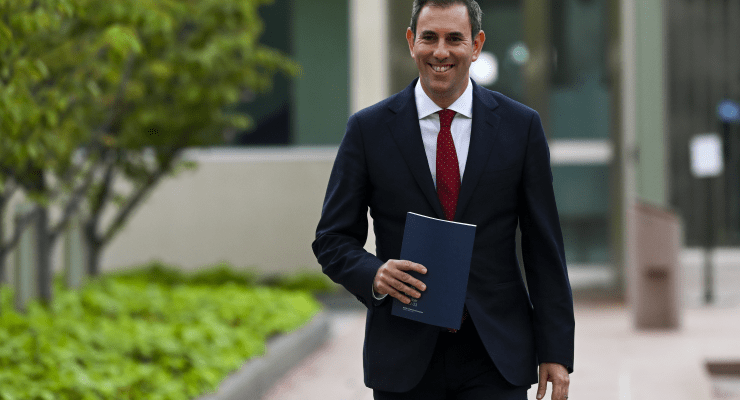
It was supposed to be Australia’s first “well-being budget”. But on Tuesday night, Treasurer Jim Chalmers underdelivered.
After promising a new way of economic planning and forecasting, he gave us a budget that looked pretty much like any other. It projected the broad economic impacts of government policies, but not the social, health or distributional effects. Sure, he added a “measuring what matters” section, but it spent more time explaining how other countries have tracked their nation’s well-being than actually doing so here.
After making a fuss of our New Zealand-inspired pivot, most media haven’t bothered reporting what little detail was in the budget’s new section; journalists flicked straight to the usual taxes and spending.
But what it lacked in substantive change could soon be made up for. The government has earmarked a standalone report to be released next year to provide a more comprehensive overview of the nation’s social, physical and mental health.
Nonetheless, this year’s budget paper does repackage some interesting data on Australia’s well-being, mainly from the Organisation for Economic Co-operation and Development (OECD). The upshot? All is not “well”.
Disappointment is in the detail
The main finding is that Australia is “better than the OECD average on 21 of the 32 headline indicators” of well-being.
It’s performing better on “more traditional indicators [such as] household income, household wealth, employment rates and the capital base”. On some indicators such as gender equality, income inequality and time off work, we’re behind the pack but stable or improving.
Conversely, on life satisfaction, trust in government, student skills and more, we’re above average but declining. And on threatened species, household debt, labour underutilisation and more, we’re worse than average and still going backwards.
However, the OECD’s framework has its flaws. First, it ranks Australia “at/better than OECD average and stable/improving” on housing affordability. The next line item might as well have been a bulk purchase of flying pigs! As the budget paper acknowledges, this misclassification is down to the way the OECD measures housing affordability — it includes the amount of one’s income spent on housing (rent or mortgage), but not the cost of saving for a home deposit, which has worsened markedly in the past two decades.
Other acknowledged caveats include the employment stats not accounting for concentrated unemployment in particular communities, and the education stats not accounting for attendance — both of which understate the issues faced by First Nations communities.
And the OECD framework also has shortcomings which Treasury didn’t acknowledge. For instance, it incorporates income inequality (which it finds improved between 2012-18, though we’re still worse than average) but not wealth inequality. The Australian Institute of Health and Welfare’s (AIHW) latest welfare report found the latter had increased in the past two decades.
There are also notably absent indicators, such as homelessness, domestic violence and poverty, on which we aren’t performing particularly well. AIHW finds, for instance, that the number of individuals finding work after going through the “job active” system for welfare recipients declined, and the number of Australians who couldn’t raise $2000 within a week for an emergency rose 5.1% from 2010-20.
Taking a broader look
Treasury gestured towards tightening these measurements for the next budget, but suggested it would continue using OECD data. The OECD has plenty of publicly available Australian data already, so we can make a head start.
Its 2022 How’s Life report includes some data not mentioned in the budget. For instance, Australians have an above-average risk of anxiety and depression, gained more weight and consumed more alcohol than the average person. Before the pandemic we had above-average trust in government; now we’re below average. We also had below-average rates of young people not in employment, education or training; now we’re above average.
Our top 10% of households are not quite as rich compared with some of their OECD counterparts. But zoom out to our top 20%, and they’re richer relative to the bottom 20% than their foreign business-class compatriots. Their relative life satisfaction compared with the bottom 20% is slightly lower, however — our upper class appear to be killjoys.
Finally, the disparity in science scores between students from the wealthiest and least wealthy families is worse than elsewhere, underlining our failure to address educational inequality.
A safe, wealthy country trashing its advantages
The upshot of all this? Australia is a safe, wealthy country, but one squandering many of its natural advantages with poor policies to distribute the benefits and ensure sustainability.
Chalmers has positioned his well-being budget approach as a tool to chip away at these deficiencies, and his budget included some worthy items that will improve our collective well-being. But right now we’re barely describing the depths of our social malaise, let alone turning it around.
Should Jim Chalmers have done more to keep his “well-being” promise alive? Let us know your thoughts by writing to letters@crikey.com.au. Please include your full name to be considered for publication. We reserve the right to edit for length and clarity.








Is anyone really surprised that the Sh*t-lite party hasn’t really created systemic change?
They’ve followed the Sh*t party more and more to the right for the past 2 decades (at least).
Er, make that 4 decades at least. Remember, Bobbie Hawke was the Reagan-Thatcher down-under branch secretary. Even Red Gum said so in their excellent song.
Good to see Alan Kohler ‘coming out’ (in a podcast with David Speers) and saying he is an MMTer, and that Chalmers should stop bleating about “debt and deficits as far as the eye can see”.
A currency-issuing government need only concern itself with the quality of its spending, not debt and deficits which indeed constrain private sector players.
Well spotted and totally agree. This tosh is nothing more than neoliberal franchise-think. Weak!